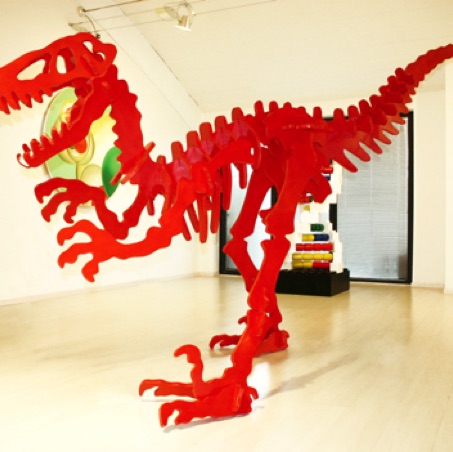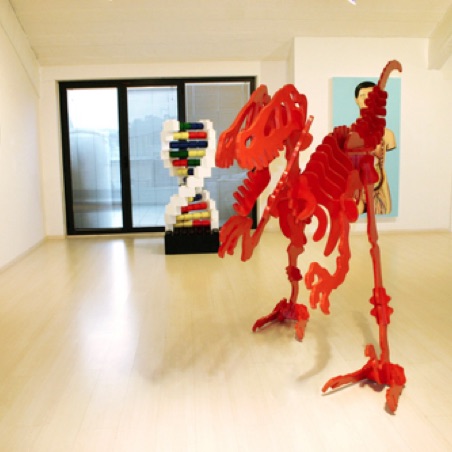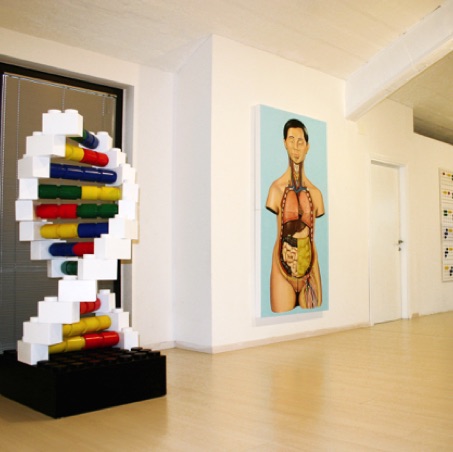giorgiolupattelli
BUILDINGS
2006. Galleria Artsinergy (SAN BENEDETTO DEL TRONTO)
clicca sulle immagini
BUILDINGS
di Maurizio Coccia
L’assunto centrale della poetica di Giorgio Lupattelli, così come ci viene presentata in questa occasione, consiste in un accertamento empirico della soglia di affinità fra scienza e arte.
Ma in concreto, cosa significa? Innanzitutto, ciò comporta la registrazione e l’assimilazione dei parallelismi esteriori, più manifesti, tra i due campi. Ed è proprio da qui, che prende spunto la sua particolare iconografia, basata sostanzialmente sulle analogie formali e sulla natura sperimentale del lavoro artistico e di quello scientifico. Poi, una volta verificate le reciprocità superficiali, Lupattelli rileva invece una fondamentale differenza intrinseca, di struttura. Perché, se l’evoluzione scientifica procede annullando i vecchi risultati in favore di quelli nuovi, nell’arte ciò – semplicemente – non può avvenire.
Prendiamo, ad esempio, i lavori esposti. I rimandi alla storia dell’arte anche recente (da Leonardo a Piero, da Warhol a Pascali a Hirst), sono frequenti e perfettamente contestualizzati. Però, attenzione, non si tratta di mollezze postmoderne. Né di libere citazioni o parodistiche scimmiottature. Sono piuttosto, vere appropriazioni, così a lungo metabolizzate da essere ormai costitutive, connaturate al sistema di immagini in cui Lupattelli (e noi con lui) vive. Perché tale è la situazione dell’artista contemporaneo. Ed era già chiaro fin dal medioevo: noi siamo nani sulle spalle di giganti. Solo così riusciamo a guardare un po’ più lontano.
Comunque, tornando al discorso iniziale, secondo Giorgio arte e scienza coincidono nella metodologia. Cioè esse hanno in comune un tipo particolare di procedura, a carattere combinatorio, costruttivo. In sintesi, la ricerca di laboratorio “gioca” con il DNA e le particelle nucleari, l’arte mescola materiali, confonde linguaggi, moltiplica le esperienze. In questo caso, il titolo della mostra parla chiaro: BUILDINGS. Ovvero costruzioni, montaggi, assemblaggi. È una logica che, a scorrere tutti i lavori, vediamo articolata su tre registri complementari: 1) simbolico; 2) iconografico; 3) tecnico. Basta osservare, solo per fare qualche esempio riassuntivo, la serie Bionacle Building o il pannello coi “chiodi” colorati Toy Building.
Però, però... Se ci fermiamo un momento e ci facciamo assorbire dalla presenza fisica delle opere, l’impressione finale che si ha, è diversa. Sarà per le caratteristiche esteriori (cromatiche, tattili, dimensionali), ma la nostra attenzione viene catturata dal loro – inquietante – aspetto ludico. È come se Lupattelli volesse dirci che l’uomo, mediante la scienza sembra giocare coi propri limiti (OMG, staminali, ecc.), senza tenere nel giusto conto le conseguenze.
Quindi, per suffragare la tesi, niente di più appropriato che realizzare giocattoli di perversa piacevolezza.
Non credo di fare torto all’autore, se dico che queste opere si presentano come giocattoli fuori scala. Anche perché, frequentemente, la sua ispirazione viene proprio da quell’ambito. Ma questi oggetti, costruiti con una perizia manifatturiera sorprendente, non svolgono solo una funzione metaforica. Oltre ad una evidente denuncia delle aberrazioni del fondamentalismo scientista, ci dicono qualcosa di più personale e, al contempo, meno allarmante. Perché Giorgio sa perfettamente che giocare è un modo per stare fuori dalle regole inventandosene delle nuove.
The central assumption of Giorgio Lupattelli’s poetics, as is the case of this exhibition, deals with an empirical check of affinity threshold between Science and Art.
What does it mean in concrete terms? First of all it involves cognizance and assimilation of the more evident external parallelism between the two. His peculiar iconography starts just from here. It is substantially based on formal analogies and on the experimental nature of the artistic and scientific work. Then, once checked the superficial reciprocities, Lupattelli finds out a fundamental intrinsic and structural difference. In fact, if scientific evolution goes on nullifying old results in behalf of the new ones, this cannot simply happen when dealing with art.
Let’s take into consideration the works on display. The several references to history of art, recent history as well, are perfectly pertinent to the contest (from Leonardo to Piero, from Warhol to Pascali and Hirst). Just a warning: keep in mind that they are neither post-modern luxury nor free quotations or parodying imitations. They are rather true appropriations which have been metabolized for such a long time that by now they are constitutive parts of the image system where Lupattelli lives (and so do we with him). Such is the situation of the contemporary artist. It was already clear during Middle Ages: we are dwarfs on giants’ shoulders. This is the only way which allows us to see a bit farther.
However, according to Giorgio, if we go back to the starting point we will see that art and science share a similar methodology. What they have in common is a special kind of modality characterized by a combinatory and constructive procedure. In brief, lab research “plays” with DNA and nuclear particles while art mixes up materials, languages and increases experiences. In this case, the title of the exhibition is quite clear: BUILDINGS. It means construction, assemblage. If we glance through all his works this logic is articulated on three complementary levels: 1) the first one is symbolic; 2) the second one is iconographic; 3) the third one is technical. Have a look at the series Bionacle Building or at the panel with the coloured nails Toy Building.
However if we stop for a moment and let ourselves be absorbed completely by the physical presence of his art works the final impression is completely different. In fact our attention is captured by their disquieting recreational aspect, maybe because of their external characteristics (the chromatic, tactile and size impressions). It is as if Lupattelli would tell us that Man, through science, is likely to play with his own limits (GMO, staminal cells, etc.), without taking into any account the consequences. Then, In order to support his thesis, nothing is more appropriate than making toys characterised by a perverse pleasantness.
I believe I don’t wrong the author if I say that these works of art are something like out of scale toys. In fact, quite frequently, his inspiration is drawn from that ambit. But these subjects, built with a surprising manufacturing ability, does not have a metaphorical function. Besides an evident denounce of the aberrations characterising the scientific fundamentalism, they tell us something more personal and at the same time less alarming. Giorgio knows very well that playing is a way of not abiding by rules and to invent new ones.


